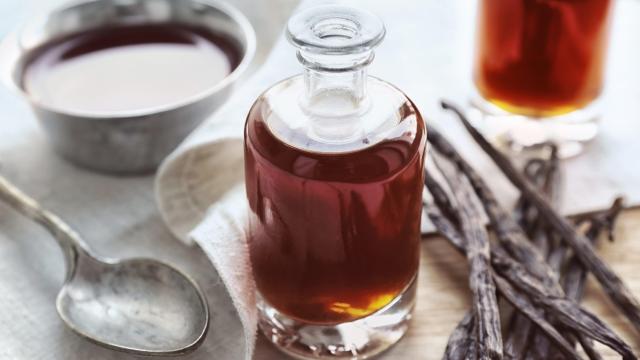Plunking a scraped and spent vanilla bean into an aliquot of alcohol is a good idea. (Those beans are expensive, and you might as well eek out that last bit of flavour.) Buying whole, pricey pods for the express purpose of making your own extract, however, is not a good idea. Simply put: You don’t have access to the equipment or technology required to make a fully realised, deeply flavored and complex bottle of vanilla extract in your home kitchen.
Like me, you’ve probably seen a few fancy food people stick a whole bunch of vanilla beans in a big jar of bourbon or vodka and brag about their “DIY vanilla extract,” but the truth is they’re wasting their time and money. Vanilla has more than 400 flavour compounds to extract and, while a lot of them are ethanol soluble, a lot of them are water soluble, and many of them cannot be accessed with a simple table-top extraction performed at room temperature and pressure.
As Stella Parks of Serious Eats explains in her article on the subject (which you should read in its entirety), the process for making vanilla extract varies from company to company, but it is always more complex than tossing vanilla beans in alcohol and calling it a day:
Cold extractions generally involve processing the vanilla through various quantities and percentages of ethanol under constant circulation, for weeks or months, with each round aimed at pulling out a different range of vanilla’s 400+ compounds. By changing the ethanol percentage with each wash, a new range of flavour can be extracted. In the end, these individual washes are blended together to create the finished vanilla. Broadly speaking, cold extractions tends to have a character that’s more fruity and floral, sometimes with rum-like qualities.
Hot or pressurised extractions may involve all of that and more, as the vanilla beans and ethanol may be held at various temperatures and pressures, each likewise suited to extract a different range of flavour compounds that will later be blended into a single product. Some producers may use percolation to extract yet another range of vanilla compounds. This type of vanilla tends toward a darker character, with notes of caramel, dried fruit, or even oak.
This is all to say that tossing beans into bourbon will make for a lovely, vanilla-scented bourbon, but you’ll miss out on the bean’s full, layered, and complex range of flavorful compounds. So buy a real, properly extracted extract (Stella has recs), and save your beans for those moments when you wish to incorporate the seeds into your baking, then toss the empty pod into some fernet or, better yet, try one of Stella’s hot infusions. You may not be able to control the pressure of your extraction, but you can manipulate the temperature.

Leave a Reply
You must be logged in to post a comment.